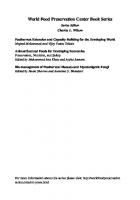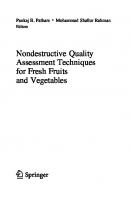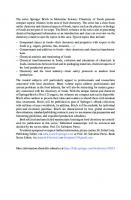Postharvest Diseases of Fruits and Vegetables: Development and Control [1 ed.] 0444505849, 9780444505842, 9780080539294
Focusing on the great variety of research being done in the field of postharvest pathology, this volume presents a colle
292 46 269KB
English Pages 431 Year 2001
Table of contents :
Front Cover......Page 1
Postharvest Diseases of Fruits and Vegetables: Development and Control......Page 4
Copyright Page......Page 5
CONTENTS......Page 8
PREFACE......Page 12
CHAPTER 1. INTRODUCTION......Page 14
B. The Origin of the Pathogens......Page 16
C. Spore Germination......Page 17
D. Pathogen Penetration into the Host......Page 24
A. Host-Pathogen Combinations in Postharvest Diseases......Page 38
B. The Main Pathogens of Harvested Fruits and Vegetables......Page 40
A. Preharvest Factors, Harvesting and Handling......Page 46
B. Inoculum Level......Page 48
C. Storage Conditions......Page 50
D. Conditions Pertaining to the Host Tissues......Page 55
E. Host-Pathogen Interactions......Page 64
A. Enzymatic Activity......Page 67
B. Toxin Production......Page 72
C. Detoxification of Host-Defense Compounds by Pathogens......Page 77
B. Inhibitors of Cell-Wall Degrading Enzymes......Page 79
C. Preformed Inhibitory Compounds......Page 82
D.Phytoalexins–Induced Inhibitory Compounds......Page 89
E. Wound Healing and Host Barriers......Page 97
F. Active Oxygen......Page 103
G. Pathogenesis-Related Proteins......Page 105
A. Changes in Fruit Respiration and Ethylene Evolution......Page 107
B. Ethylene Source in Infected Tissue......Page 113
C. Pectolytic Activity and its Source in Infected Tissue......Page 115
D. Stimulation of Fruit Softening and Changes in the Pectic Compound Contents......Page 116
E. Changes in Biochemical Constituents of Infected Tissues......Page 118
A. Cold Storage......Page 121
B. Modified and Controlled Atmospheres......Page 134
C. Growth Regulators......Page 150
D. Calcium Application......Page 155
A. Preharvest Chemical Treatments......Page 160
B. Sanitation......Page 163
C. Postharvest Chemical Treatments......Page 167
D.Generally Recognized As Safe (GRAS) Compounds......Page 183
E. Natural Chemical Compounds......Page 190
F. Lectins......Page 197
A. Heat Treatments......Page 202
B. Ionizing Radiation......Page 218
C. Ultraviolet Illumination......Page 230
CHAPTER 11. BIOLOGICAL CONTROL......Page 234
A. Isolation and Selection of Antagonists......Page 235
B. Introduction of Antagonists for Disease Control......Page 239
C.Mode of Action of the Antagonist......Page 246
D. Antagonist Mixtures to Improve Disease Biocontrol......Page 255
E. Combined Treatments to Improve Disease Control......Page 257
F. Integration into Postharvest Strategies......Page 259
CHAPTER 12. NOVEL APPROACHES FOR ENHANCING HOST RESISTANCE......Page 265
A. Induced Resistance......Page 266
B. Genetic Modification of Plants......Page 275
C. Manipulation of Ethylene Biosynthesis and Genetic Resistance in Tomatoes......Page 278
POSTHARVEST DISEASE SUMMARY FOUR FRUIT GROUPS......Page 280
I. SUBTROPICAL AND TROPICAL FRUITS......Page 281
II. POME AND STONE FRUITS......Page 306
III. SOFT FRUITS AND BERRIES......Page 323
IV. SOLANACEOUS FRUIT VEGETABLES......Page 333
SUBJECT INDEX......Page 408
Front Cover......Page 1
Postharvest Diseases of Fruits and Vegetables: Development and Control......Page 4
Copyright Page......Page 5
CONTENTS......Page 8
PREFACE......Page 12
CHAPTER 1. INTRODUCTION......Page 14
B. The Origin of the Pathogens......Page 16
C. Spore Germination......Page 17
D. Pathogen Penetration into the Host......Page 24
A. Host-Pathogen Combinations in Postharvest Diseases......Page 38
B. The Main Pathogens of Harvested Fruits and Vegetables......Page 40
A. Preharvest Factors, Harvesting and Handling......Page 46
B. Inoculum Level......Page 48
C. Storage Conditions......Page 50
D. Conditions Pertaining to the Host Tissues......Page 55
E. Host-Pathogen Interactions......Page 64
A. Enzymatic Activity......Page 67
B. Toxin Production......Page 72
C. Detoxification of Host-Defense Compounds by Pathogens......Page 77
B. Inhibitors of Cell-Wall Degrading Enzymes......Page 79
C. Preformed Inhibitory Compounds......Page 82
D.Phytoalexins–Induced Inhibitory Compounds......Page 89
E. Wound Healing and Host Barriers......Page 97
F. Active Oxygen......Page 103
G. Pathogenesis-Related Proteins......Page 105
A. Changes in Fruit Respiration and Ethylene Evolution......Page 107
B. Ethylene Source in Infected Tissue......Page 113
C. Pectolytic Activity and its Source in Infected Tissue......Page 115
D. Stimulation of Fruit Softening and Changes in the Pectic Compound Contents......Page 116
E. Changes in Biochemical Constituents of Infected Tissues......Page 118
A. Cold Storage......Page 121
B. Modified and Controlled Atmospheres......Page 134
C. Growth Regulators......Page 150
D. Calcium Application......Page 155
A. Preharvest Chemical Treatments......Page 160
B. Sanitation......Page 163
C. Postharvest Chemical Treatments......Page 167
D.Generally Recognized As Safe (GRAS) Compounds......Page 183
E. Natural Chemical Compounds......Page 190
F. Lectins......Page 197
A. Heat Treatments......Page 202
B. Ionizing Radiation......Page 218
C. Ultraviolet Illumination......Page 230
CHAPTER 11. BIOLOGICAL CONTROL......Page 234
A. Isolation and Selection of Antagonists......Page 235
B. Introduction of Antagonists for Disease Control......Page 239
C.Mode of Action of the Antagonist......Page 246
D. Antagonist Mixtures to Improve Disease Biocontrol......Page 255
E. Combined Treatments to Improve Disease Control......Page 257
F. Integration into Postharvest Strategies......Page 259
CHAPTER 12. NOVEL APPROACHES FOR ENHANCING HOST RESISTANCE......Page 265
A. Induced Resistance......Page 266
B. Genetic Modification of Plants......Page 275
C. Manipulation of Ethylene Biosynthesis and Genetic Resistance in Tomatoes......Page 278
POSTHARVEST DISEASE SUMMARY FOUR FRUIT GROUPS......Page 280
I. SUBTROPICAL AND TROPICAL FRUITS......Page 281
II. POME AND STONE FRUITS......Page 306
III. SOFT FRUITS AND BERRIES......Page 323
IV. SOLANACEOUS FRUIT VEGETABLES......Page 333
SUBJECT INDEX......Page 408
![Postharvest Diseases of Fruits and Vegetables: Development and Control [1 ed.]
0444505849, 9780444505842, 9780080539294](https://ebin.pub/img/200x200/postharvest-diseases-of-fruits-and-vegetables-development-and-control-1nbsped-0444505849-9780444505842-9780080539294.jpg)


![Handbook of Postharvest Technology: Cereals, Fruits, Vegetables, Tea, and Spices (Books in Soils, Plants, and the Environment, Volume 93) [1 ed.]
0824705149, 9780824705145, 9780824747282](https://ebin.pub/img/200x200/handbook-of-postharvest-technology-cereals-fruits-vegetables-tea-and-spices-books-in-soils-plants-and-the-environment-volume-93-1nbsped-0824705149-9780824705145-9780824747282.jpg)




![Field Manual of Diseases on Fruits and Vegetables [1 ed.]
978-94-007-5973-2, 978-94-007-5974-9](https://ebin.pub/img/200x200/field-manual-of-diseases-on-fruits-and-vegetables-1nbsped-978-94-007-5973-2-978-94-007-5974-9.jpg)

